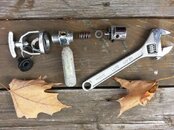Threaded cartridges were more expensive than the non threaded variety. I tested my fancy, redundant, two cartridge 32 gram cartridge system - just before I plugged it with 3/8" LP port plugs.
I then used the empty cartridges for years as first stage wrenches - since they had the same 3/8" thread.
The gem of information! Thank you. I'm off to find my horse collar and scavenge the cartridge... what a great solution for getting careful torque on a reg!
Ah I love this place.
Cameron





